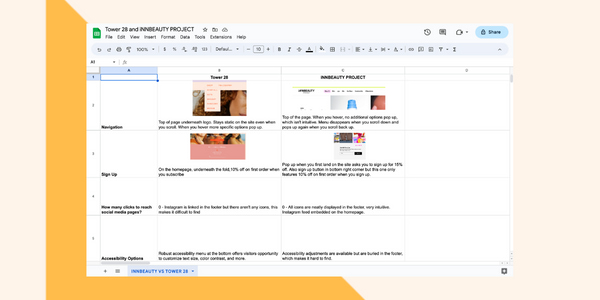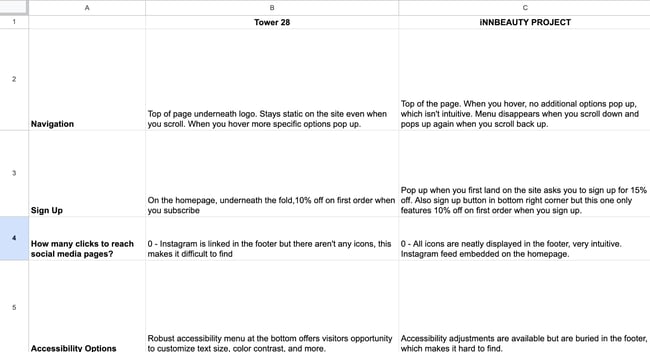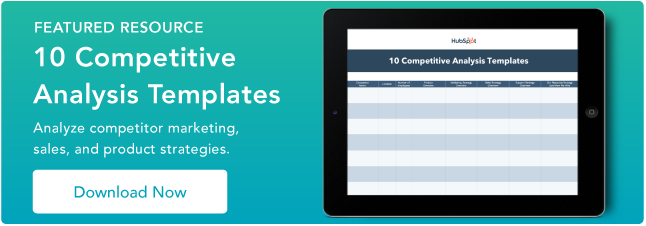What's one of the best ways to understand how your business can stand out in a saturated marketplace? UX competitive analysis, of course. Regardless of how new or established, large or small, prominent or up-and-coming your company is, completing competitor analysis UX research can help fill significant gaps.

This post will walk you through the competitor analysis that UX researchers complete. You'll learn more about UX competitive analysis, why it's crucial, how to get started, and even see an example to help get the creative juices flowing.
What is Competitive Analysis in UX?
UX competitive analysis is helpful for designers looking to gain insight into what works for the competition — and what doesn't. Competitive analysis is a user experience research method to better understand similar websites your users visit. For instance, if you're working on creating a website for a SaaS startup, you should complete a competitor analysis UX audit on other similar companies.
You might wonder if a UX competitive analysis wastes valuable time, money, and resources. The answer is no. Walking through the process lets you learn what already exists and how it functions. You'll learn the intricacies of the competitors' sites' features, flow, and structure. And no, this doesn't just apply to websites — you can use it for apps or products, too. Most importantly, you'll experience firsthand any experiences using the competitor's site evokes, such as frustration. Then, you can use that information to create a site that delights visitors.
Ultimately, thanks to what you learn through the competitive analysis process, UX designers can apply findings to ensure your website or app is up to par. For instance, you can identify recurring trends or themes through competitive analysis. You can also gain insight into user expectations and needs, shaping how designers build your site.
When should you complete a competitor analysis?
When is the best time to complete a competitor analysis? With this, the sooner, the better. With competitor analysis, UX researchers will better understand what needs to happen (or shouldn't) to make your site or app successful. Therefore, if you wait too long to complete this step, you'll likely have to backtrack.
If you're applying competitor analysis UX research to site creation and starting from scratch, ensure this step is complete before your team starts designing. Or, if you're remodeling your website, you should do this at the early stages of the site refresh.
Of course, new competitors can pop up at any time, so make sure you revisit your findings and open and re-evaluate if it's time to complete another analysis. This will help ensure your site is up to par with others dominating the market.
Why is the competitor analysis UX researchers so essential?
The competitor analysis UX researchers complete is crucial to your site's success because it provides insights into making your website go above and beyond what's already out there. It might not matter if that competitor is larger and more powerful than your small startup if the competitor's site is finicky and frustrates visitors due to navigation issues.
You'll learn your competitors' weaknesses with UX competitive analysis, and then you can use that insight to finetune your website. As a result, your business can do something the competition can't: Provide visitors with a seamless user experience that leaves them happy to return to your website.
How to Get Started with Competitor Analysis
Now that you know competitor analysis is necessary for UX researchers, let's walk through how to begin. First, ask yourself a few questions:
-
What do I want to achieve with this competitor analysis?
-
What makes this business unique? Is it — or its target audience — comparable to mine?
-
Are there specific features I'm investigating? Some popular features include signing in, creating an account, searching on the site, making a purchase, or signing up.
Once you have the answers to those questions, it's time to outline your competition. Keep it simple by sticking with three to five competitors. Anything more than that, and your analysis quickly becomes overwhelming and less comprehensive.
Now, you'll want to create a place to store your findings. The most efficient way to do this is by creating a spreadsheet where your learnings are easy to find. Once done, you can complete a heuristic evaluation of your competitors' sites. (Have questions about where to start with that heuristic eval? We've got you covered.)
When you're on their site, identify on your spreadsheet the most critical features users engage with. For instance, you might immediately notice the competitor has a prominent search bar, massive navigation menu, and thorough footer. Depending on the competitor's site, feel free to customize the features you're investigating.
Once you've identified what features you're making a note of on your spreadsheet, walk through each and complete it like you're a user. In your spreadsheet, you can note how you feel about the features. For example, mention if the menu disappears too quickly if you move your mouse or think the website navigation isn't accessibility-friendly.
Once you've repeated the steps for the other two to four websites you identified as competition, and your website, if it's already created, you can create a takeaway list regarding what the competitors' strengths and weaknesses are. From there, you will have more insight into must-haves as you bring your site to life.
UX Competitive Analysis Example
Let's run through a UX competitive analysis example to help you get a better feel for what to expect. Say we have a small, vegan, cruelty-free makeup line for which we're launching a website. In this example, we'll compare the websites of two makeup companies: Tower 28 and iNNBEAUTY PROJECT.
If we were completing this analysis, we'd follow the steps outlined and create a spreadsheet that looks like this:

We focused on navigation, social media account presence, email sign-up options, and accessibility options. Here's a close-up look at what our analysis looks like:

Now that we have this information, we'd use it to create insights into what's important to us as we build our site. For instance, we didn't like that iNNBEAUTY PROJECT buried its accessibility options in the footer. When creating our site, we'd consider that.
Best Practices for Competitive Analysis UX Research
Now that you're armed with knowledge on getting started and examples to help guide you, here are some competitive analysis UX research best practices to remember.
Don't overdo it.
There's no reason to compare yourself to 10 competitors. With this form of research, more isn't necessarily merrier. Instead, stick with your three to five main competitors. And once you get your key takeaways from their site, abandon it. Remember: You're not trying to copy their design. You're trying to get inspiration to ensure your site excels.
Include your site in the analysis — if it's already built.
If your site or app is already built, remember to include it in the analysis. Seeing it compared to the competition will help you look deeper into where your site excels or falls short.
Consider further testing.
Competitive analysis should give you a thorough understanding of competitors' site functionality and how yours stacks up. But sometimes, more testing truly is needed. Consider usability testing or a preference test.
Know what you're looking for.
Are there specific features you're targeting with this research? For instance, do you want to hone in on how competitors' navigation impacts user experience? Or do you want to analyze the placement of their CTAs? Either way, jot down exactly what features you're looking into — the more specific, the better.
Use competitor analysis UX research to inspire your site design.
Now that you've discovered more about this research method and seen a UX competitive analysis example, it's time to begin applying your learnings to your website. Trust us: Your user experience will be better for it!
![Download Now: 10 Competitive Analysis Templates [Free Templates]](https://no-cache.hubspot.com/cta/default/53/b3ec18aa-f4b2-45e9-851f-6d359263e671.png)

![Website Navigation: The Ultimate Guide [Types & Top Examples]](https://blog.hubspot.com/hubfs/ft-nav-bar.webp)
![What Is End-User Experience Monitoring? [+Tips For Implementing It]](https://blog.hubspot.com/hubfs/end-user-experience-monitoring.png)




